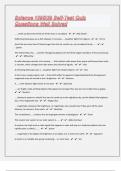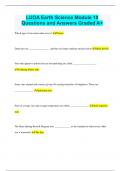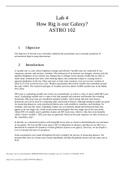Sun size and brightness - Study guides, Class notes & Summaries
Looking for the best study guides, study notes and summaries about Sun size and brightness? On this page you'll find 65 study documents about Sun size and brightness.
Page 3 out of 65 results
Sort by

-
Astronomy 102 Final Exam Study Guide | 100% Correct Answers | Verified | Latest 2024 Version
- Exam (elaborations) • 16 pages • 2024
-
- $10.49
- + learn more
Which layer of the sun does nuclear fusion take place? - Core Which layer of the sun is between the photosphere and the radiation zone? - Convection zone What two forces in the sun balance to determine the physical size of the sun? - Gravity and Radiation pressure How does the density of the sun change as the distance from the center of the sun increases? - decreases How does the temperature of the sun change as the distance from the center of the sun increases? - decreases How does ener...

-
Science 1095|39 Self-Test Quiz Questions Well Solved
- Exam (elaborations) • 3 pages • 2024
-
- $6.49
- + learn more
......make up about two-thirds of all the stars in our galaxy - ️️Red dwarfs Reflecting telescopes use a dish-shaped, or concave,.....to gather light from objects - ️️mirror stars that are more than 20 times larger than the sol, earths sun, are considered to be...... - ️️giants The Andromeda, the,.....,and the Triangulum galaxies are the three largest members of the Local Group. - ️️Milky Way A radio telescope consists of a concave,..... that collects radio waves from space a...

-
LUOA Earth Science Module 10 Questions and Answers Graded A+
- Exam (elaborations) • 5 pages • 2023
- Available in package deal
-
- $8.99
- + learn more
LUOA Earth Science Module 10 Questions and Answers Graded A+ Which type of star emits radio waves? Pulsars Dead stars are ________________ , and they no longer undergo nuclear fusion black dwarfs Stars that appear to pulsate but are non-pulsating are called ___________________. eclipsing binary stars Some stars expand and contract giving off varying intensities of brightness. These are _______________. pulsating stars Stars of average size and average temperature are called _______________. ...

-
CPV 301 Final Exam | Q & A (Complete Solutions)
- Exam (elaborations) • 61 pages • 2024
-
- $28.49
- + learn more
CPV 301 Final Exam | Q & A (Complete Solutions) The input of computer vision is an image. So what is the output of computer vision? A. The output is the interpretation of an image. B. The output is a processed image. C. The output is the image that has been recovered with the parts that have been noisy- D. All of the others What system does the digital camera use to perform the digitization of images? A. Number system. B. Logic system C. Sensor system D. Optical system In K-means for Segmentat...

-
ASTRO 2ND EDITION SHOHINI GHOSE - Test Bank
- Exam (elaborations) • 264 pages • 2023
-
- $22.84
- + learn more
1. Which of the following definitions best describes a constellation? a. a region of the sky containing a certain star pattern b. a group of very bright stars c. a group of very faint stars d. the dividing line between the north and south celestial hemispheres ANSWER: a 2. How many official constellations are there? a. 98 b. 88 c. 13 d. 55 ANSWER: b 3. Which of the following best describes the Big Dipper? a. an asterism b. a faint star near...

-
Earth Science 1086 Midterm 1(complete 2022/2023
- Exam (elaborations) • 5 pages • 2022
-
- $9.99
- 1x sold
- + learn more
Law, Theory, Hypothesis Hypothesis: educated guess with observation. -WHY Theory: summarizes hypothesis by testing. - WHY Law: explains observations - HOW Singularity an area in space-time where gravitational force is so high, all known laws of physics break down. Evidence of Big Bang - Three Pillars of Proof 1. Hubble's Law 2. characteristics of cosmic microwave background radiation 3. abundance of light elements 1. Hubbles Law - there are many galaxies - the univ...

-
Astronomy Exam 1 with Questions and Answers
- Exam (elaborations) • 3 pages • 2024
-
Available in package deal
-
- $7.99
- + learn more
Astronomy Exam 1 with Questions and Answers Astronomical Unit ANSWER the average distance from the earth to the sun Light-year ANSWER the distance light travels in one year Parallax ANSWER the apparent change in position of an object when you look at it from different places All stars are____ ANSWER huge spheres of glowing gas What are the 3 characteristics used to classify stars? ANSWER size, temprature, and brightness Apparent Magnitude ANSWER it's brightness as seen from ...

-
LAB 4 ASTR 102
- Exam (elaborations) • 4 pages • 2022
-
- $8.49
- 2x sold
- + learn more
Lab 4 How Big is our Galaxy? ASTRO 102 1 Objective The objective of this lab was to introduce methods that astronomers use to estimate properties of astronomical objects using observations. 2 Introduction A variable star is a star whose brightness changes periodically. Variable stars are comprised of two categories, intrinsic and extrinsic variables. The luminosity of an intrinsic star changes, whereas only the apparent brightness of an extrinsic star changes due to changes in the amoun...

-
DSST Astronomy Test Prep Questions and Answers
- Exam (elaborations) • 6 pages • 2024
-
Available in package deal
-
- $10.49
- + learn more
terrestrial planet (rocky planet) a planet with a solid surface, that is mainly composed of rock and solid materials gaseous planet (gas giants) a planet that has little to no solid surface and is mostly composed of gases dwarf planet a planet that is too small to be considered a full planet light-year the distance that light travels in one year, roughly 6 trillion miles or 63,000 AU parsec a unit of measurement in astronomy, equals to about 206,000 AU or 3.2 light-years magnitude...

-
Astro 7N "Copper Quiz Questions" (Units 3 & 4), ASTRO EXAM TWO (ANSWERED)
- Exam (elaborations) • 9 pages • 2024
-
Available in package deal
-
- $9.49
- + learn more
What is the general result of the proton-proton chain? - Correct Answer 4H = He + energy + other products The corona of the sun... - Correct Answer is visible during a solar eclipse In the convection zone of the Sun... - Correct Answer columns of hot gas rise, cool, and descend What part of the sun do we typically see? - Correct Answer Photosphere In nuclear fusion, energy is produced because... - Correct Answer The mass of the reacting chemicals is larger than that of the ...

How did he do that? By selling his study resources on Stuvia. Try it yourself! Discover all about earning on Stuvia


